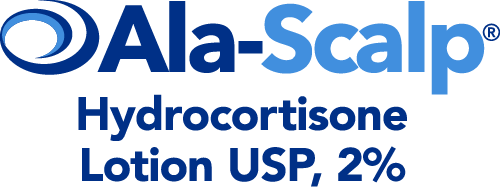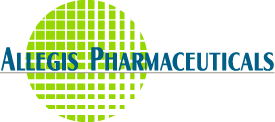
*See Eligibility and Restrictions by clicking on the copay coupon link above.
Ala-Scalp Hydrocortisone Lotion, 2%
Ala-Scalp Hydrocortisone Lotion is used to help relieve redness, itching, swelling, or other discomfort caused by skin conditions. This medicine is a corticosteroid (cortisone-like medicine or steroid).
What is Ala-Scalp?
Targeted therapy for mild Corticosteroid Responsive Dermatoses
Ala-Scalp is Safe
- Safe for use on patients of all ages. including pediatric patients
- Safe for use on thinned-skinned areas such as the face, chest, groin, and axilla
Ala-Scalp is Effective
- Relieves itching and inflammation
- Ideal for use on sebaceous glands, and any oily or hair-bearing areas
Ala-Scalp is Convenient
Unique lotion vehicle allows for easy spreadability in a clear, fast-drying and non-greasy formulation
INDICATIONS AND USAGE
Hydrocortisone Lotion is indicated for the relief of the inflammatory and pruritic manifestations of corticosteroid-responsive dermatoses.
Important Safety Information
CONTRAINDICATIONS
Hydrocortisone Lotion is contraindicated in those patients with a history of hypersensitivity to any of the components of the preparation.
PRECAUTIONS
- Systemic absorption of topical corticosteroids has produced reversible hypothalamic-pituitary-adrenal (HPA) axis suppression, manifestations of Cushing’s syndrome, hyperglycemia, and glucosuria in some patients.
- Conditions which augment systemic absorption include the application of the more potent steroids, use over large surface areas, prolonged use, and the addition of occlusive dressings.
- Therefore, patients receiving a large dose of a potent topical steroid applied to a large surface area or under an occlusive dressing should be evaluated periodically for evidence of HPA axis suppression by using the urinary free cortisol and ACTH stimulation tests. If HPA axis suppression is noted, an attempt should be made to withdraw the drug, to reduce the frequency of application, or to substitute a less potent steroid.
- Recovery of HPA axis function is generally prompt and complete upon discontinuation of the drug. Infrequently, signs and symptoms of steroid withdrawal may occur, requiring supplemental systemic corticosteroids.
- Pediatric patients may absorb proportionally larger amounts of topical corticosteroids and thus be more susceptible to systemic toxicity (See PRECAUTIONS-Pediatric Use).
- If irritation develops, topical corticosteroids should be discontinued and appropriate therapy instituted.
- In the presence of dermatological infections, the use of an appropriate antifungal or antibacterial agent should be instituted. If a favorable response does not occur promptly, the corticosteroid should be discontinued until the infection has been adequately controlled.
ADVERSE REACTIONS
The following local adverse reactions (in order of decreasing frequency) are reported infrequently with topical corticosteroids (but may occur more frequently with occlusive dressings): burning, itching, irritation, dryness, folliculitis, hypertrichosis, acneiform eruptions, hypopigmentation, perioral dermatitis, allergic contact dermatitis, maceration of the skin, secondary infection, skin atrophy, striae, miliaria.
References:
- Seborrheic Dermatitis. The Merck Manual. http://merckmanuals.com/professional_dermatologic_disorders/dermatitis/seborrheic_dermatitis. html. Accessed 05/02/2017.
- Ala-Scalp® Full Prescribing Information. Derm Ventures LLC, Petal, MS 39465.
- Hydrocortisone Topical. MedlinePlus Drug Information. http://www.nlm.nih.gov/medlineplus/druginfo/meds/a682793.html. Accessed 05/03/2017.
- Hydrocortisone FAQ. National Eczema Association. http://nationaleczema.org/eczema/treatment/topical-corticosteroids/hydrocortisone-faq/. Accessed 05/04/2017.
- Buys LM. Treatment Options for Atopic Dermatitis. Am Fam Physician. 2007;75(4):523-528.
- Rathi, S. et al. Rational and Ethical Use of Topical Corticosteroids Based on Safety and Efficacy. Indian Journal of Dermatology. 2012;57(4):251-259.
- Ortiz, B et al. Infective Dermatitis in an Adult Patient with HTLV- 1. Am J Dermatopathol. 2015;37(12).
- https://www.aad.org/public/diseases/eczema/stasis-dermatitis. Retrieved 5/7/18.
- https://www.nhsinform. scot/illnesses-and-conditions/ears-nose-and-throat/otitis-externa#treatment. Retrieved 5/7/18.
- https://www.dermnetnz.org/topics/meyerson-naevus. Retrieved 5/7/18.

*See Eligibility and Restrictions by clicking on the copay coupon link above.
Ala-Scalp Hydrocortisone Lotion, 2%
Ala-Scalp Hydrocortisone Lotion is used to help relieve redness, itching, swelling, or other discomfort caused by skin conditions. This medicine is a corticosteroid (cortisone-like medicine or steroid).
What is Ala-Scalp?
Targeted therapy for mild Corticosteroid Responsive Dermatoses
Ala-Scalp is Safe
- Safe for use on patients of all ages. including pediatric patients
- Safe for use on thinned-skinned areas such as the face, chest, groin, and axilla
Ala-Scalp is Effective
- Relieves itching and inflammation
- Ideal for use on sebaceous glands, and any oily or hair-bearing areas
Ala-Scalp is Convenient
Unique lotion vehicle allows for easy spreadability in a clear, fast-drying and non-greasy formulation
INDICATIONS AND USAGE
Hydrocortisone Lotion is indicated for the relief of the inflammatory and pruritic manifestations of corticosteroid-responsive dermatoses.
Important Safety Information
CONTRAINDICATIONS
Hydrocortisone Lotion is contraindicated in those patients with a history of hypersensitivity to any of the components of the preparation.
PRECAUTIONS
- Systemic absorption of topical corticosteroids has produced reversible hypothalamic-pituitary-adrenal (HPA) axis suppression, manifestations of Cushing’s syndrome, hyperglycemia, and glucosuria in some patients.
- Conditions which augment systemic absorption include the application of the more potent steroids, use over large surface areas, prolonged use, and the addition of occlusive dressings.
- Therefore, patients receiving a large dose of a potent topical steroid applied to a large surface area or under an occlusive dressing should be evaluated periodically for evidence of HPA axis suppression by using the urinary free cortisol and ACTH stimulation tests. If HPA axis suppression is noted, an attempt should be made to withdraw the drug, to reduce the frequency of application, or to substitute a less potent steroid.
- Recovery of HPA axis function is generally prompt and complete upon discontinuation of the drug. Infrequently, signs and symptoms of steroid withdrawal may occur, requiring supplemental systemic corticosteroids.
- Pediatric patients may absorb proportionally larger amounts of topical corticosteroids and thus be more susceptible to systemic toxicity (See PRECAUTIONS-Pediatric Use).
- If irritation develops, topical corticosteroids should be discontinued and appropriate therapy instituted.
- In the presence of dermatological infections, the use of an appropriate antifungal or antibacterial agent should be instituted. If a favorable response does not occur promptly, the corticosteroid should be discontinued until the infection has been adequately controlled.
ADVERSE REACTIONS
The following local adverse reactions (in order of decreasing frequency) are reported infrequently with topical corticosteroids (but may occur more frequently with occlusive dressings): burning, itching, irritation, dryness, folliculitis, hypertrichosis, acneiform eruptions, hypopigmentation, perioral dermatitis, allergic contact dermatitis, maceration of the skin, secondary infection, skin atrophy, striae, miliaria.
References:
- Seborrheic Dermatitis. The Merck Manual. http://merckmanuals.com/professional_dermatologic_disorders/dermatitis/seborrheic_dermatitis. html. Accessed 05/02/2017.
- Ala-Scalp® Full Prescribing Information. Derm Ventures LLC, Petal, MS 39465.
- Hydrocortisone Topical. MedlinePlus Drug Information. http://www.nlm.nih.gov/medlineplus/druginfo/meds/a682793.html. Accessed 05/03/2017.
- Hydrocortisone FAQ. National Eczema Association. http://nationaleczema.org/eczema/treatment/topical-corticosteroids/hydrocortisone-faq/. Accessed 05/04/2017.
- Buys LM. Treatment Options for Atopic Dermatitis. Am Fam Physician. 2007;75(4):523-528.
- Rathi, S. et al. Rational and Ethical Use of Topical Corticosteroids Based on Safety and Efficacy. Indian Journal of Dermatology. 2012;57(4):251-259.
- Ortiz, B et al. Infective Dermatitis in an Adult Patient with HTLV- 1. Am J Dermatopathol. 2015;37(12).
- https://www.aad.org/public/diseases/eczema/stasis-dermatitis. Retrieved 5/7/18.
- https://www.nhsinform. scot/illnesses-and-conditions/ears-nose-and-throat/otitis-externa#treatment. Retrieved 5/7/18.
- https://www.dermnetnz.org/topics/meyerson-naevus. Retrieved 5/7/18.

